Kayda Variations Part 1
Example of Variations in Kayda Solo Performance
Introduction to Kayda Variations
In both practice and performance, kayda themes are not performed by themselves; a kayda is developed through variations.
Practicing kayda variations does at least two things very well:
- Develops specific hand techniques
- Develops fluency with the language
For this reason, students will do long hours of kayda practice; there is no better way to learn the language and improve your technique at the same time.
In tabla solos, an extended presentation of creative kayda variations is considered one of the highest skills of the art form.
In this section and the next, we will discuss some of the most common characteristics of variations, and how they are traditionally presented.
Memorizing and Creating Variations
Students are expected to memorize the kayda variations that their teacher gives them. Although most students now write down their variations, they are still expected to play them from memory.
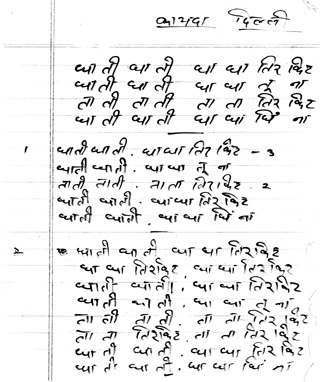
Main Bol and Variations Written by Chhotelal Misra, 1986
When students memorize variations in the order that their teacher gives them, they are absorbing well-formed variations in a traditional sequence.
However, the goal is not simply to memorize. The goal is for students to eventually create and present their own variations which "sound right" for any particular kayda.
General Guidelines for Creating Kayda Variations
Across the gharanas, nearly everyone agrees on a few basic guidelines for creating kayda variations:
- Variations should use only bols from the original theme.
- Variations should keep the original tali-khali structure of the theme.
- Variations are developed systematically (more or less).
We’ll look at the first two guidelines below and at the third in the next section.
Before moving on, there is another traditional guideline worth mentioning:
- Variations should retain the original character of the theme.
This guideline is subjective and difficult to define. In some cases, modern players have very free interpretations of this guideline, or they seem to ignore it altogether. But many traditionalists feel it is important.
Variations should use only bols from the original theme
The most commonly accepted guideline for kayda variations is that only bols from the main bol (theme) should be used.
Remember that the term bol can refer to both individual strokes, and groups of strokes. When we talk about the bols in kayda variations, we are usually talking about groups of strokes like tete, tirakita, and dhinna. Single bols like dha and ta can also be manipulated independently in kaydas, but they are usually kept together with other bols.
In our beginner’s kayda, the bols are dha/ta, tete, and tuna/dhinna (dha/ta and tuna/dhinna are tali-khali counterparts):
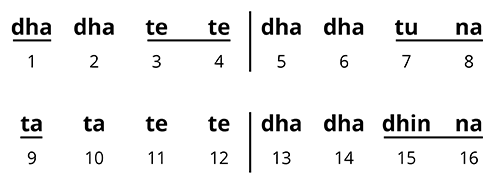
Traditional variations of this kayda would be based on manipulating these three groups of bols. But we would not use bols like tirakita, dheradhera, or gheranaga because they are not in the theme.
In the next section, we will look at some variations for this kayda which focus on these three bols: dha/ta, tete, and tuna/dhinna. You can also look for yourself at the variations for Benares Kayda 1, or watch again the video above, which uses most of those variations.
Variations should keep the original tali-khali structure of the theme
As we saw in the last section, tintal kaydas have the same general tali-khali pattern as tintal itself: tali-tali-khali-tali (stressed-stressed-unstressed-stressed). Most kayda variations will keep this same tali-khali structure, though they may be longer, or shorter, than the original theme.
Remember that the general stress pattern in kaydas is created by the baya (bass drum) strokes: sections with at least some open baya strokes are tali (stressed), and sections with closed baya are khali (unstressed).
Here again is our beginner’s kayda with open baya strokes in bold:

Theme Performed Twice
If we divide the kayda into quarters, we have:
- Two quarters tali
- One quarter khali
- One quarter tali
When we make variations, this general structure is usually kept, regardless of which bols are used, or how long the variation is.
Variation Example 1
For example, here is the first variation for our beginner’s kayda:
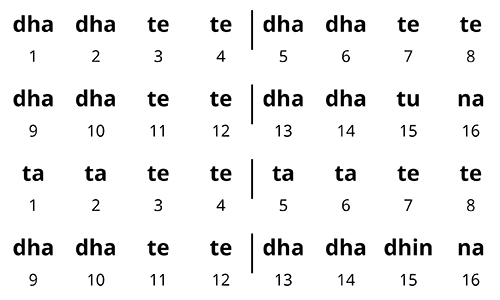
Variation Example 1 – Spoken Twice
Variation Example 1 – Performed Twice
This variation keeps the same overall tali-khali structure (tali-tali-khali-tali), but it is twice as long as the theme.
If we look at the stress pattern of the vibhags, we see it more clearly:
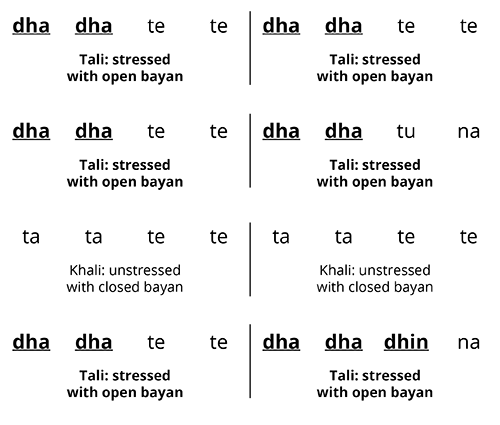
If we now divide this variation into quarters, we see that it keeps our original tintal structure: tali-tali-khali-tali:
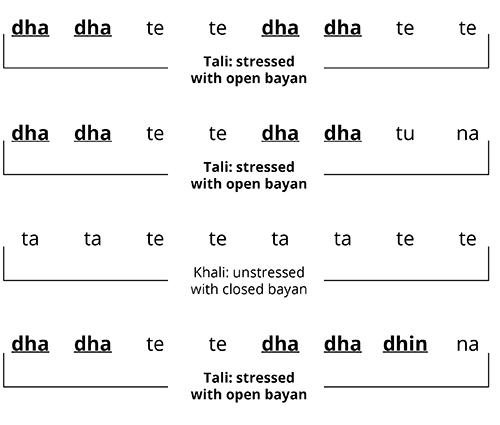
So we have doubled the length of each half of the theme. And because the third quarter will be khali, we must then double the length of the khali section. So the khali section is now 8 matras instead of 4.
Also, notice that this variation keeps the parallel pattern of the theme: the second half repeats the first half, but with a different baya pattern.
Variation Example 2
Here is another variation for the same kayda above (V5):

Variation Example 2 – Spoken Twice
Variation Example 2 – Performed Twice
In this variation, the first line is new (matras 1–8) but the second line (matras 9–16) is the same as the last variation. The second half is the khali counterpart (matras 1–8), followed by the theme again.
This gives us the same overall tali-khali pattern:
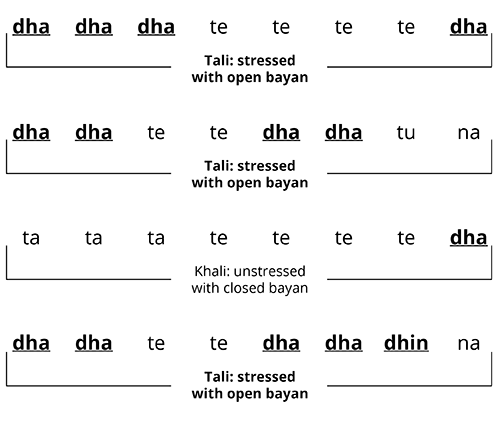
(Notice the tali bol dha at the end of the khali section. This parallels the dha at the end of the first line. This is an example of khali not always being exactly one quarter in length.)
So almost all variations will keep this same overall stress pattern, whether they are longer or shorter than the theme.
Listen to any variation of the tintal kaydas on this website and you should hear this same overall pattern.
In the next section, we will look more closely at how kayda variations are developed systematically.
References
Kippen, James. The Tabla of Lucknow – A Cultural Analysis of a Musical Tradition. Cambridge: Cambridge University Press, 1988.
Misra, Chhote Lal. Tal Prasoon. New Delhi: Kanishka Publishers, 2004. (Hindi)
—. Tal Prabandh. New Delhi: Kanishka Publishers, 2006. (Hindi)
Naimpalli, Sadanand. Tabla for Advanced Students. Mumbai: Popular Prakashan Pvt. Ltd., 2009.
Stewart, Rebecca Marie. The Tabla in Perspective. Unpublished Ph.D. thesis, University of California, Los Angeles, 1974.